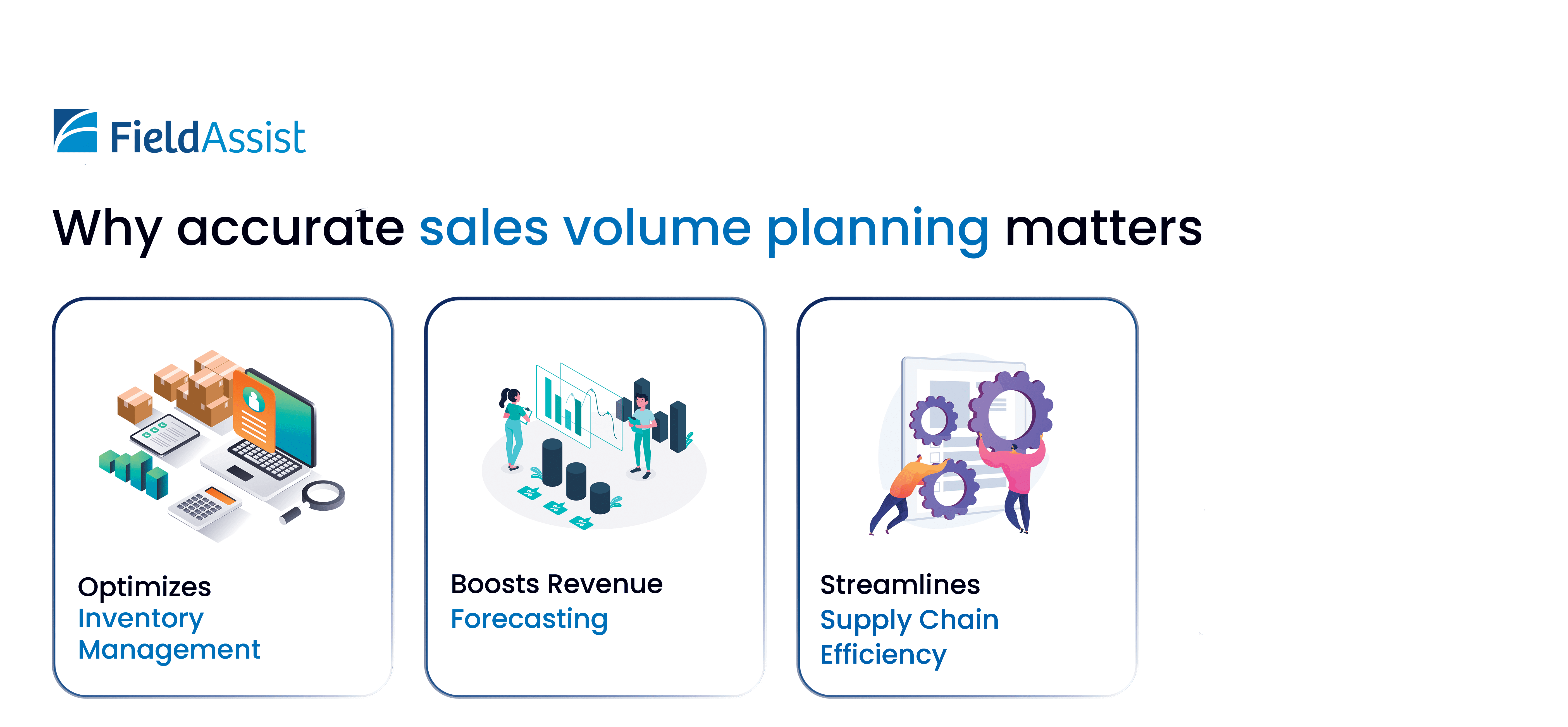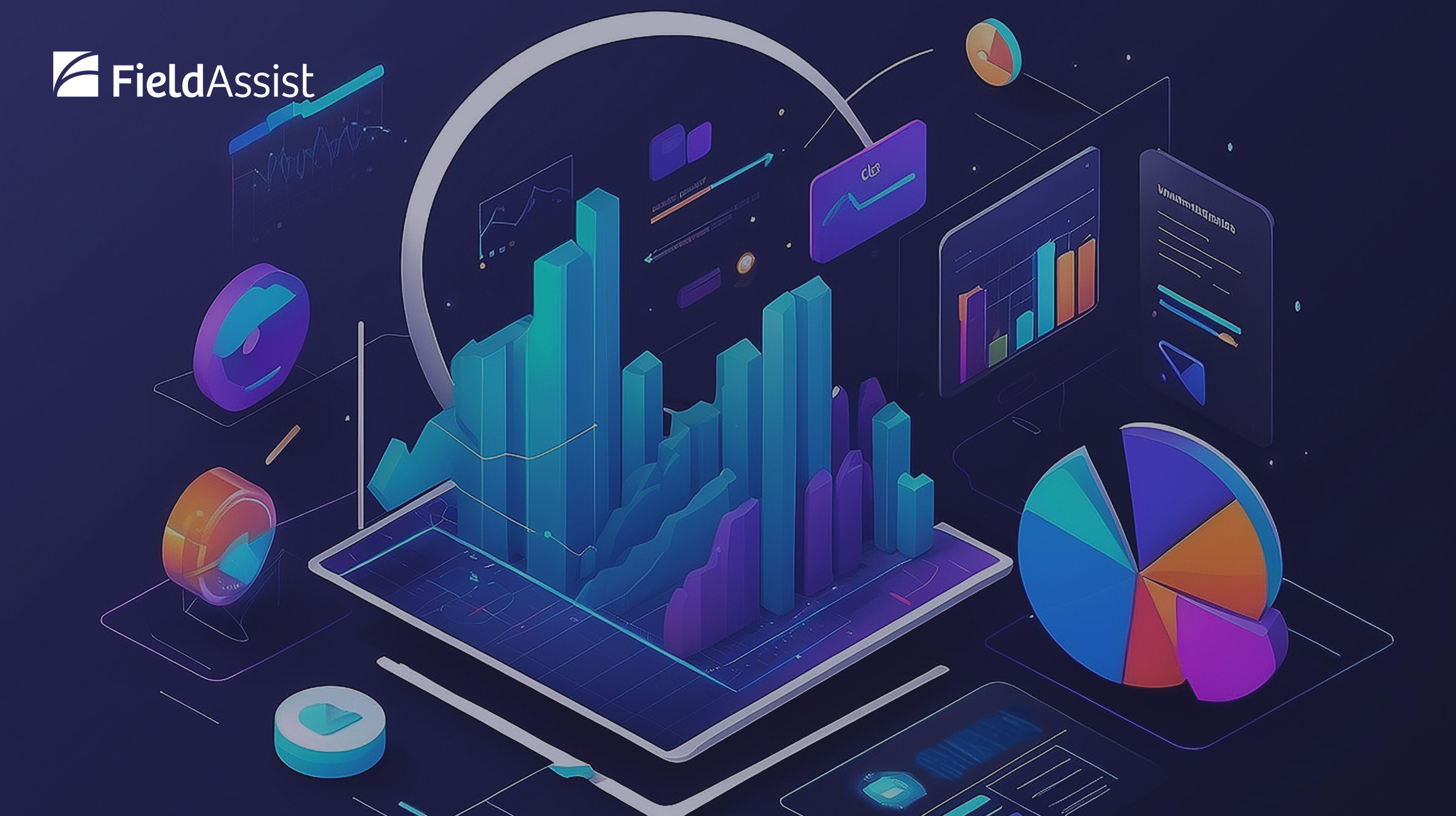Table of Contents
ToggleDo you know why some businesses always meet their sales targets while others struggle to keep up in the market? The secret lies in planning.
Sales volume planning is like preparing for a cricket match. You need to have the right strategy, the right plan, and teamwork to win. In 2025, with changing markets and smarter customers, guessing sales numbers will not work anymore. Businesses need accurate sales forecasting powered by insights and data. This way they can easily know how much to sell and where to sell. But most importantly, businesses need a right planning approach to ensure their products are in the right outlets, at the right time and in the right quantity.
But how can we plan better in such a fast moving world?
For this, one must be able to predict market trends, avoid stock wastage, and always stay one step ahead of customer needs.
With advancements in AI tools and more innovative technologies, achieving accurate sales planning is no longer a dream. In this blog, we will show you practical steps and real-life examples to help you build a future-ready sales volume plan that not only meets demand but also drives growth.
Why Accurate Sales Volume Planning Matters?
For industries like FMCG, where every decision impacts revenue, effective sales planning becomes the foundation of success. If you misjudge the demand, it can disrupt your entire operation.
With precise forecasting sales volume, businesses can manage these risks better, ensuring they meet customer expectations while staying profitable.
Here’s why accurate sales volume planning matters:

- Optimizes Inventory Management: Sales volume planning helps businesses strike that perfect balance, avoiding stockouts that frustrate customers and overstock that drains resources.
- Boosts Revenue Forecasting: Accurate sales planning helps you predict sales performance more precisely, so you can confidently make smarter financial decisions.
- Streamlines Supply Chain Efficiency: A well-planned supply chain aligns production, distribution, and delivery to meet market demands without delays or waste.

The Role of Demand Forecasting in SVP
Accurate sales volume planning is crucial, but it all starts with understanding the demand. Demand Forecasting acts as a guiding light for businesses. It’s not just about guessing what customers might buy but more about using data to anticipate trends and prepare for the future.
But what happens when demand forecasting goes wrong?
- Supply Chain Disruptions: Think of a supply chain as a domino effect – one wrong move and everything tumbles. Inaccurate sales projections can lead to production halts, delayed deliveries, and missed opportunities to meet customer needs.
- Inventory Mismanagement: Imagine having warehouses overflowing with unsold products while customers are asking for something you’ve run out of. Poor demand forecasting creates either costly overstocks or damaging stock-outs, hurting both your cash flow and reputation.
- Lost Sales Opportunities: Every time a product is unavailable when a customer needs it, that’s a missed sale. Worse, it might push your customers to explore competitors.
Demand forecasting bridges these gaps by providing actionable insights based on historical data, market trends, and seasonality. It ensures that businesses stay ahead of the curve, aligning their supply chains and inventory strategies with real-world demand.
How FieldAssist improves Demand Forecasting?
Businesses these days need tools and strategies that can turn uncertainty into clear, actionable plans. Advanced systems like FAi can analyze vast amounts of data from past sales trends to real-time market changes and can provide accurate demand forecasts. These tools empower businesses to prepare for future challenges, avoid stock issues, and make smarter decisions.
At FieldAssist, we take demand forecasting a step further by combining cutting-edge technology with easy-to-use solutions:
- AI-Powered Forecasting Tools: Our solutions analyze historical sales patterns and market trends to provide precise demand predictions. This ensures businesses can stock the right products at the right time.
- Mobile-First Sales Force Automation: With our mobile-friendly platforms, sales teams get real-time insights on customer behavior and market trends, helping them make faster, data-backed decisions.
- Distributor Management Systems (DMS): Our DMS enables businesses to track inventory and distributor performance, ensuring supply aligns perfectly with market demand.
- Customizable Dashboards: FieldAssist provides visually rich dashboards that let you track and predict demand trends easily.
By integrating these technologies, FieldAssist helps businesses stay ahead of market shifts, reduce inventory wastage, and ensure seamless supply chain operations. Whether you’re an FMCG company looking to expand or a growing business aiming for higher efficiency, our solutions provide the clarity you need to make informed decisions.

Role of Target Automation for Sales Volume Success
Setting sales targets is a critical aspect of any business’s sales strategy. However, the traditional process of setting and managing sales targets is often time-consuming and prone to errors. Without a streamlined approach, sales teams might face misaligned targets that don’t support the business’s long-term goals. This can lead to missed revenue opportunities and an overall decline in sales performance.
The problems with the traditional process of setting and managing sales targets are:
- The Challenges of Manual Target Setting: Many businesses still rely on manual methods or outdated software to set sales targets. This approach is often inefficient and error-prone. Sales teams may spend countless hours manually calculating targets, adjusting quotas, and reviewing performance, only to end up with incorrect or misaligned goals. Such delays and inaccuracies can hurt the team’s focus and productivity, ultimately impacting the business’s overall success.
- The Misalignment of Targets with Business Objectives: When targets are not aligned with the broader business strategy, the entire sales process can become disconnected. For example, a company may set sales targets based on last year’s performance rather than considering changes in market conditions, product availability, or shifting customer needs. This results in misaligned goals, where sales teams may focus on low-priority products or territories, rather than driving growth in strategic areas. The lack of alignment can lead to missed opportunities for higher profits and market expansion.
- The Cost of Missed Revenue Opportunities: Setting ineffective sales targets doesn’t just waste time, it directly affects revenue. When sales targets are either too low or unrealistic, it results in underperformance or missed sales opportunities. Moreover, without accurate and timely targets, sales teams might focus on areas that aren’t yielding the highest returns, leaving potential revenue on the table. This inefficiency leads to missed revenue opportunities that could have been capitalized on with better forecasting and automated target setting.
How Does Target Automation Solve These Problems?
With target automation, businesses can overcome these challenges by setting data-driven, precise sales targets that are perfectly aligned with business objectives. Here’s why target automation is a game-changer:
- Saves Time and Reduces Errors: Automated systems set sales targets based on real-time data, removing the need for manual calculations and minimizing the risk of errors. Sales managers can focus on strategy rather than administrative tasks.
- Aligns Targets with Business Growth: Automation ensures that sales targets are continuously aligned with the company’s broader business objectives. Whether it’s launching new products or expanding into new regions, targets are adjusted to match those strategic goals.
- Maximizes Revenue with data-driven targets: By automating target setting, businesses can allocate resources more efficiently, focusing on areas with the highest growth potential. This leads to better sales performance, improved team productivity, and, ultimately, increased revenue.
The Question for 2025: Will Your Sales Volume Planning Evolve Fast Enough?
As we look to 2025, sales volume planning is poised for a major transformation. The rapid advancements in technology, real-time data analytics, and artificial intelligence (AI) are reshaping how businesses forecast, plan, and manage their sales volumes. In fact, many industry leaders acknowledge that data-driven sales strategies will be a key differentiator for businesses looking to thrive in the next few years.
But the real question for businesses is: Will your sales volume planning evolve fast enough to beat the competition?
Don’t let outdated methods hold you back. Contact us today to learn how FieldAssist can transform your sales strategy and set you up for success in 2025 and beyond!
About Post Author
Ankita Joshi
A Product Marketing Manager with 10+ years in marketing and advertising, expert in strategy, brand positioning, and go-to-market execution to drive growth.


